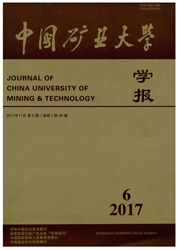

 中文摘要:
中文摘要:
为了确定卸压程度,降低卸压过程中围岩强度弱化对巷道稳定的不利作用,基于应变软化准则建立了变形压力的力学模型,依据变形压力的变化规律分析了有控卸压机理,并提出了“临界塑性区半径”作为有控卸压的判定准则.结合某软岩大巷的有控卸压支护实践,确定该巷道的“临界塑性区半径”为7.78m,并将该结果应用于有控卸压支护参数的设计.工程应用表明,通过对卸压程度的合理控制,不但有效释放了围岩的变形能减小围岩对支护体的变形压力,并能降低围岩强度弱化对围岩稳定的不利作用,提高二次锚杆支护效果,保证了支护强度满足要求,使巷道处于长期稳定状态.
 英文摘要:
英文摘要:
An acceptable amount of pressure relief was found that, at the same time, minimized the disadvantageous effects caused by weakening the surrounding rock. A model for deforma- tion under compressive stress was developed based on strain softening criteria. An analysis of the pressure relief mechanism showed that "critical-plastic-area radius" could be taken as the criteria for the degree of pressure relief. This radius was found to be 7.78 meters in a roadway conforming to typical practice when controlling pressure in soft-rock. The critical-plastic-area radius was used in the design of supports where pressure relief control was needed. Practice shows that the deformation energy in the surrounding rock is released and the compressive stress in the support is therefore reduced. This decreases the effects of weakening in the sur- rounding rock. Support from secondary bolting is thus improved by reasonable degrees from pressure relief. This guarantees the strength of the supports and assures roadway stability for a long time.
 同期刊论文项目
同期刊论文项目
 同项目期刊论文
同项目期刊论文
 Control mechanism and application of doubly supported roadways with large rigidity and high strength
Control mechanism and application of doubly supported roadways with large rigidity and high strength Using particle swarm optimization algorithm in an artificial neural network to forecast the strength
Using particle swarm optimization algorithm in an artificial neural network to forecast the strength Research on the mechanism of pressure relief based on the analysis of compressive stress deformation
Research on the mechanism of pressure relief based on the analysis of compressive stress deformation 期刊信息
期刊信息
